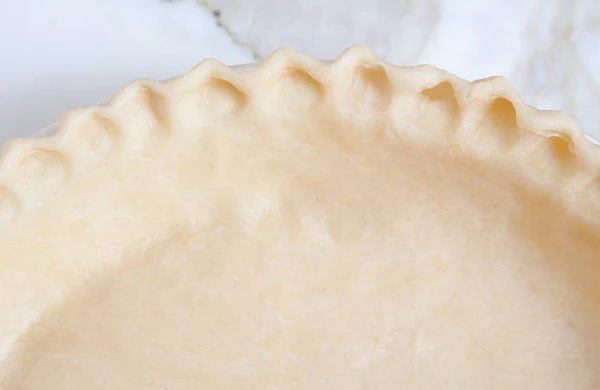Granny's All-Purpose Oil Based Pie Crust

Pie crust - the very foundation of the dessert itself. A too dry or over-baked crust can ruin an otherwise perfectly good pie. But forget about breaking out the rolling pin. Granny may have started baking at 5 in the morning but her pie crust recipe is as easy as. . . pie.
This oil-based pie crust forms a perfect pastry base without all the fuss of rolling out a buttery crust. Just press it directly into the pie pan for a deliciously versatile crust made easy! This pie crust is suitable for almost any type of sweet pie imaginable, Chocolate Cream to Lemon Meringue.

Ingredients
1 3⁄4 cups flour 2 teaspoons powdered sugar 1⁄2 teaspoons salt 1⁄2 cup vegetable oil 1 tablespoon olive oil 3 tablespoons milk 1 tablespoon vodka
Method
- 1. Preheat the oven to 425 F (218 C). Dump the flour, sugar, and salt in a 9-inch pie pan. A cast iron pan is a great alternative for a more old-fashioned pie. Mix the dry ingredients with a fork.
- 2. In a separate bowl, use a fork to whisk together the vegetable oil, vodka, and milk until emulsified.
- 3. Add the fluid mixture to the dry ingredients, then take a fork and mix all around. Then take your fingers and mix it up good, finally pressing the dough into the pie pan.
- 4. Bake the pie crust for 15 to 20 minutes.

The Secret to Flaky Perfection: Tips for Creating the Ideal Pie Crust
Granny was a simple woman, and her All-Purpose Pie Crust deliciously proves the point. Why use a rolling pin if you don’t have to? Granny knew there were better places to use that elbow grease, so she used her classic oil crust whenever possible. And she was happy to do her part to put to rest the tired cliché of an old woman wielding a rolling pin.
Granny’s recipe calls for your regular, run-of-the-mill products, so there’s no need to splurge on high-end butter or hand-milled organic flour. But a basic understanding of the ingredients and how they interact makes for a better baker.
A pie shell relies on two main ingredients: fats and flour. Let’s start with the fats. Many pie recipes call for a butter or shortening fat, or more often, a combination of the two. Both of these fats fulfill a role. Butter adds flavor while shortening helps to create a light and flaky texture by inhibiting the formation of gluten strands and cross-links.
A butter and shortening pie crust can be tasty and tender, but it typically requires the fats to be chilled before use, making their integration with the dry ingredients more challenging. This type of crust also needs to be rolled out, and close attention must be paid to proper hydration. An oil-based shell, however, skips over these complications without sacrificing one bit of flavor or flakiness.
Be sure to use plain old vegetable or canola oil as the main fat so as not to overpower the flavor of the pie. Other oils can be used in its place, but take care to select a neutral oil. Olive oil, for instance, has too strong a flavor of its own to be suitable as the main oil. But used in moderation, olive oil adds a hint of depth to a pie crust, heightening its flavor profile.
The ideal pie crust is light and flaky, but the very creation of the dough presents an inherent challenge. When flour mixes with a liquid, it forms gluten, a protein that gives structure to bread products. Gluten's nebulous web of fibrous strands gloriously gives shape to a risen loaf of bread, but it can wreak havoc on a pie crust.
Flours with a lower protein content are generally recommended for pies since they don’t produce as much gluten. Pastry flour usually contains 8.5% - 9.5% protein, but these lower protein levels risk turning out a crust that is actually too tender and fails to hold a shape at all. The use of all-purpose flour, which has a slightly higher protein level of between 10% - 12%, ameliorates the danger. And don’t worry about excess gluten in your pie crust - Granny keeps a secret ingredient in her liquor cabinet.
Adding a bit of vodka to the pie crust will slow gluten formation in the dough, giving it a moist, pressable character and helping to eliminate the need for a rolling pin. Granny prefers just a touch of the good stuff, but other bakers recommend substituting up to 50% of the liquid in a recipe with vodka. Other hard liquors can be used for this purpose, but vodka is prized for leaving no smell or taste. All of the alcohol burns off during the bake, so this advanced baking technique is safe for children and teetotalers alike. The result is a sublime flakiness, sure to win over even the most die-hard prohibitionist.
The All-Purpose Oil Based Pie Crust is perfect for any single-crust cream or fruit pie. Pies that require an additional upper shell will find more success with a sturdier butter and shortening crust.